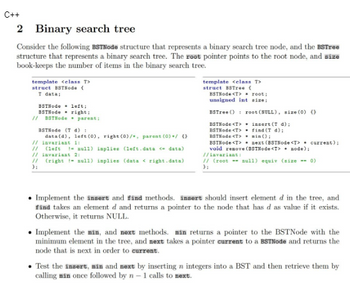
Database System Concepts
7th Edition
ISBN: 9780078022159
Author: Abraham Silberschatz Professor, Henry F. Korth, S. Sudarshan
Publisher: McGraw-Hill Education
expand_more
expand_more
format_list_bulleted
Concept explainers
Question

Transcribed Image Text:C++
2 Binary search tree
Consider the following BSTNode structure that represents a binary search tree node, and the BSTree
structure that represents a binary search tree. The root pointer points to the root node, and size
book-keeps the number of items in the binary search tree.
template <class T>
struct BSTNode (
T data;
BSTNode left;
BSTNode right;
// BSTNode. parent;
BSTNode (T d) :
data (d), left (0), right (0)/, parent (0) / 0
// invariant 1:
// (left
// invariant 21
(right! null) inplies (data < right.data)
};
aull) implies (left.data <- data)
template <class T>
struct BSTree (
BSTNode <T>
root;
unsigned int size:
BSTree ()
BSTNode <T>
BSTNode <T>
BSTNode <T>.min();
root (NULL), size (0) ()
insert (T d);
find (T d);
BSTNode <T>next (BSTNode <T> current);
void renove (BSTNode <T> node);
//invariant:
// (root = null) equiv (size -- 0)
};
Implement the insert and find methods. insert should insert element d in the tree, and
find takes an element d and returns a pointer to the node that has d as value if it exists.
Otherwise, it returns NULL.
• Implement the min, and next methods. min returns a pointer to the BSTNode with the
minimum element in the tree, and next takes a pointer current to a BSTNode and returns the
node that is next in order to current.
• Test the insert, min and next by inserting n integers into a BST and then retrieve them by
calling min once followed by n-1 calls to next.
Expert Solution
This question has been solved!
Explore an expertly crafted, step-by-step solution for a thorough understanding of key concepts.
This is a popular solution
Trending nowThis is a popular solution!
Step by stepSolved in 4 steps with 4 images

Knowledge Booster
Learn more about
Need a deep-dive on the concept behind this application? Look no further. Learn more about this topic, computer-science and related others by exploring similar questions and additional content below.Similar questions
- Please write the code in C. The screenshot attched provides the template to write in C.arrow_forward1. Stack 2. Queue 3. Singly-linked list 4. Binary search tree 5. AVL tree 6. Priority queue 7. Hash table Can be used as an auxiliary data structure for expression evaluation with a binary tree. Often implemented with complete binary trees satisfying a partial order property. Data is not ordered, but insertion and search are expected to take O(1) time. Data is fully ordered, insertion, removal and search are guaranteed to be less than O(n) time.arrow_forwardData structure Javaarrow_forward
- Java programming homework Please help me with this Question. I really need to understand itarrow_forwardTree.java: This is a simple binary tree class that should be used to represent the data in your Huffman tree. You only need to implement two of the methods (_printTree and compareTo). Huffman.java: This file contains all of the logic required to implement a Huffman tree. The code in this file relies on the Tree.java file. You must provide the implementation for all of the methods in this class. public class Main { /* * tree.txt should produce this tree: * 16 * / \ * 6 Z * / \ * A D * * A (1), D (5), Z (10) * * Codes: * A: 00 * D: 01 * Z: 1 * * Preorder Traversal: * 16, 6, 1 (A), 5 (D), 10 (Z) */ public static void main(String[] args) throws Exception { Huffman huff = new Huffman(); huff.buildTreeFromFile("tree.txt"); // Print the tree: System.out.println("printTree tests:"); huff.printTree(); // Expected output: [16: , 6: , 1:A, 5:D, 10:Z] // Get some codes:…arrow_forwardAlert dont submit AI generated answer. Define a Binary Search Tree. Explain the advantage of a Binary Search Tree data structure. Create a Binary Search Tree (visually the way we did in the class) on the following input data. Show the status of the values during each step. NOTE: You have to describe the condition(s) used and the steps justifying the task of placing the value at a location. 34, 21, 43, 19, 20, 39, 19, 52arrow_forward
arrow_back_ios
arrow_forward_ios
Recommended textbooks for you
 Database System ConceptsComputer ScienceISBN:9780078022159Author:Abraham Silberschatz Professor, Henry F. Korth, S. SudarshanPublisher:McGraw-Hill Education
Database System ConceptsComputer ScienceISBN:9780078022159Author:Abraham Silberschatz Professor, Henry F. Korth, S. SudarshanPublisher:McGraw-Hill Education Starting Out with Python (4th Edition)Computer ScienceISBN:9780134444321Author:Tony GaddisPublisher:PEARSON
Starting Out with Python (4th Edition)Computer ScienceISBN:9780134444321Author:Tony GaddisPublisher:PEARSON Digital Fundamentals (11th Edition)Computer ScienceISBN:9780132737968Author:Thomas L. FloydPublisher:PEARSON
Digital Fundamentals (11th Edition)Computer ScienceISBN:9780132737968Author:Thomas L. FloydPublisher:PEARSON C How to Program (8th Edition)Computer ScienceISBN:9780133976892Author:Paul J. Deitel, Harvey DeitelPublisher:PEARSON
C How to Program (8th Edition)Computer ScienceISBN:9780133976892Author:Paul J. Deitel, Harvey DeitelPublisher:PEARSON Database Systems: Design, Implementation, & Manag...Computer ScienceISBN:9781337627900Author:Carlos Coronel, Steven MorrisPublisher:Cengage Learning
Database Systems: Design, Implementation, & Manag...Computer ScienceISBN:9781337627900Author:Carlos Coronel, Steven MorrisPublisher:Cengage Learning Programmable Logic ControllersComputer ScienceISBN:9780073373843Author:Frank D. PetruzellaPublisher:McGraw-Hill Education
Programmable Logic ControllersComputer ScienceISBN:9780073373843Author:Frank D. PetruzellaPublisher:McGraw-Hill Education

Database System Concepts
Computer Science
ISBN:9780078022159
Author:Abraham Silberschatz Professor, Henry F. Korth, S. Sudarshan
Publisher:McGraw-Hill Education

Starting Out with Python (4th Edition)
Computer Science
ISBN:9780134444321
Author:Tony Gaddis
Publisher:PEARSON

Digital Fundamentals (11th Edition)
Computer Science
ISBN:9780132737968
Author:Thomas L. Floyd
Publisher:PEARSON

C How to Program (8th Edition)
Computer Science
ISBN:9780133976892
Author:Paul J. Deitel, Harvey Deitel
Publisher:PEARSON

Database Systems: Design, Implementation, & Manag...
Computer Science
ISBN:9781337627900
Author:Carlos Coronel, Steven Morris
Publisher:Cengage Learning

Programmable Logic Controllers
Computer Science
ISBN:9780073373843
Author:Frank D. Petruzella
Publisher:McGraw-Hill Education